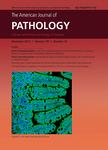版权所有:内蒙古大学图书馆 技术提供:维普资讯• 智图
内蒙古自治区呼和浩特市赛罕区大学西街235号 邮编: 010021

作者机构:Indiana Univ Sch Med Dept Pathol & Lab Med Indianapolis IN 46202 USA Univ Rochester Sch Med & Dent Dept Dermatol Rochester NY 14642 USA Washington Univ Sch Med Div Lab Med St Louis MO USA
出 版 物:《AMERICAN JOURNAL OF PATHOLOGY》 (美国病理学杂志)
年 卷 期:2002年第161卷第6期
页 面:2065-2078页
核心收录:
学科分类:1001[医学-基础医学(可授医学、理学学位)] 10[医学]
基 金:NIAMS NIH HHS [R01 AR046828 K08 AR002150 5R01 AR 40574 1R01 AR 46828 1K08 AR 02150-01A1] Funding Source: Medline
主 题:前列地尔/类似物和衍生物 前列地尔/代谢 抗体 单克隆/代谢 细胞系 细胞大小 细胞转化 肿瘤 环AMP/代谢 细胞支架蛋白质类/代谢 DNA 反义/代谢 减量调节/生理学 成纤维细胞/细胞学 成纤维细胞/代谢 遗传载体 角蛋白细胞/细胞学 角蛋白细胞/代谢 桩蛋白 表型 磷蛋白类/代谢 受体 前列腺素E/遗传学 受体 前列腺素E/代谢 皮肤/细胞学 皮肤/代谢 动物 人类
摘 要:Prostaglandin E-2 (PGE(2)) receptor subtype EP2, which is coupled to cAMP metabolism, is known to mediate proliferation of primary human keratinocytes in vitro. The effect of gain or loss of EP2 receptors in immortalized human keratinocytes;(HaCat cells) was examined. HaCat keratinocytes were transfected with sense or anti-sense constructs of the EP2 receptor. Loss or gain of EP2 expression was documented by immunoblot and associated changes in agonist-stimulated cAMP production. Loss or gain of EP2 receptor expression correlated with alterations in plating efficiencies but with modest affects on growth. When cell lines were studied in an organ culture model, antisense clones were highly invasive compared with vector controls and sense transfectants. A marked increase in prostaglandin production is commonly seen in malignant lesions. Because prostaglandin receptors are known to undergo ligand-induced receptor down-regulation, we sought to determine whether EP2 receptor down-regulation results in increased invasiveness. In vector controls, invasiveness was reproduced by ligand-dependent EP2 receptor down-regulation as assessed by immunohistochemistry. in addition, loss of EP2 receptor expression was associated with decreased paxillin expression, a critical component of focal adhesion assembly. Thus, down-regulation of EP2 receptors represents a potential mechanism for neoplastic progression to an invasive phenotype.